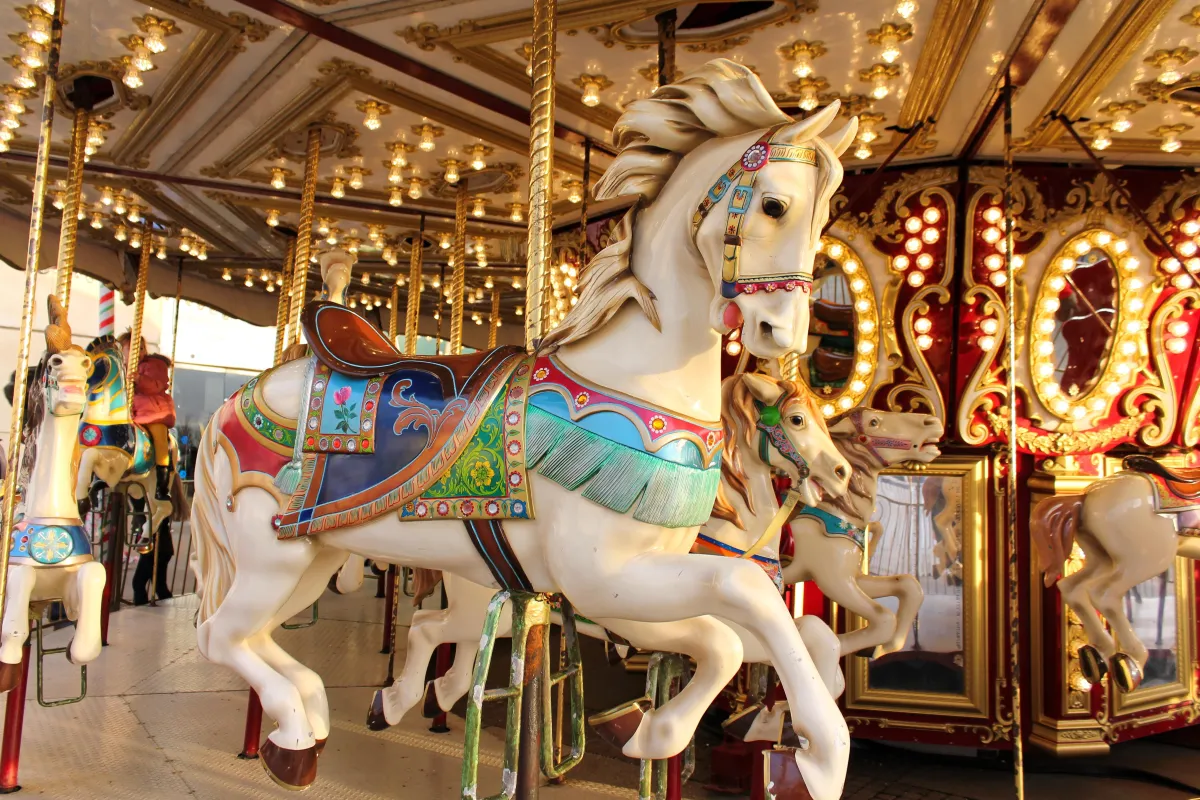Articles
Exploring History's Greatest Adventures throughout time!


CAROUSELS: A RIDE THROUGH HISTORY
Author K. L. Small shares the fascinating history of the classical amusement park ride, the carousel, which is featured in her middle grade adventure, The Magic Carousel.
A trip to an amusement park, children’s museum, or zoo often includes a ride on a carousel. This fun attraction owes its existence to historical preparations for war. Turns out the merry-go-round started with a twelfth-century Arabian horsemanship game called carosello, which means “little war.” During the Crusades, European knights discovered the game and brought the concept back to Europe when they returned home. Knights rode legless wooden horses suspended on chains to practice their tournament skills of spearing a ring.
Soon the warrior-training device became popular with the wealthy. Old images show people riding in four suspended baskets while a person turned the ride and the passengers attempted to capture a ring. Over time, the rides became larger and the human rotating the ride was replaced with a horse or mule.
In 1863, Englishman Thomas Bradshaw received a patent for using a steam engine to power the ride. That allowed the carousel to have a larger platform and more wooden horses. Sometimes, the ride was called “flying horses” because the horses were suspended on chains rather than fixed on a pole. When the ride spun around, the horse flew out on the chains. The steam engine allowed the carousel to turn faster and made for a more exciting ride.
In America, the golden age of carousels was 1860 to 1929. During this time, thousands of wooden carousels were hand-carved, mostly by immigrants. The popularity of the carousel spread as an amusement attraction. Multiple companies were formed to produce the horses and mechanisms. The most well-known styles were:
Philadelphia – realistic horses. This style was created by Gustav Dentzel, Daniel Muller, and the Philadelphia Toboggan Company (PTC).
Coney Island – elaborate and ornate figures; often with jewels. Prominent carvers were Charles Looff, William Mangels, Marcus Illions, Charles Carmel, Solomon Stein, and Harry Goldstein.
Country Fair – simpler style. Leading producers of this style were Allan Herschell, and C. W. Parker.
Carvers specialized in creating specific parts of the horse. The most respected was the person responsible for creating the head. With the expressive face and wind-swept mane, the head was the horse’s most prominent feature. Details were also added to the saddle and horse’s mane. Saddles were made wide, because at that time, women often sat side-saddle on the horse. Some horses even wore real horse shoes.
The introduction of the electric motor allowed the carousels to grow even larger. Some carousels included a feature called the spinning lover’s tub. The stationary bench element was called a chariot. Fancy carvings were added to the rounding boards and panels that covered the working mechanisms of the carousels. Lights and mirrors drew the attention of potential riders. Carousels that included animals other than horses were called menageries.
The Wall Street crash of 1929 and the resulting Depression ended the spread of hand-carved carousels in America. Technology changes led to mass-production of figures and changes in materials. Some hybrid figures had wooden bodies and metal legs. Eventually, many figures were made of molded fiberglass.
Today, there are only around 180 of the turn-of-the-century hand-carved carousels remaining in America. Some of the historical wooden carousels were destroyed by fire. Others were sold off in pieces to collectors when amusement parks closed. Some were packed away in warehouses or simply abandoned.
An organization called the National Carousel Association maintains an inventory of the remaining antique carousels. Experts specialize in the restoration and preservation of these wooden carousels. Often many layers of paint must be removed to reveal the original colors and intricate carving.
A ride on a carousel is fun for young and old. The movement of the carousel figures recreates the motion of riding a horse. The decorations on the horses depict various historic uses of the animal. Most carousels feature an armored horse, which is a reminder of the carousel’s history and origin as a warrior-training device. So, the next time you see a carousel know that you are seeing a part of history.
Recommended Reading

The Magic Carousel (Book 1 of The Brass Ring Series) by K. L. Small is a middle-grade time travel adventure story. Thanks to a magic brass ring, ten-year-old Russell rides carousel horses into the past. From the wilds of the Rocky Mountains in 1827 to medieval tournament fields, Russell learns how horses have been used in different ways throughout history. He also learns about courage and dealing with a bully.
Get the FREE Study Guide

This 11-page Guide is a resource to support The Magic Carousel (Book 1 of The Brass Ring Series) by K. L. Small. Teachers, parents, and readers are encouraged to use the discussion questions and activities in this Guide to improve the experience of reading the book. In addition to this Guide, The Magic Carousel includes a section at the back of the book called “Things You Might Want to Know” and a glossary.
© 2023. Historic Books for Kids - All Rights Reserved
Reading Pennsylvania, USA
